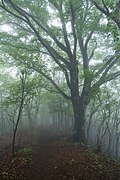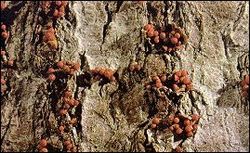| Image | Name | Subgenus | Status, systematic affinity | Distribution | Accepted in POWO, Sept. 2025 [16] |
|---|
| Fagus caspica Denk & G.W.Grimm – Caspian beech | Fagus | New species described in 2024; [1] first-diverging lineage within the Western Eurasian group | Talysch and Elburz Mountains, southeastern Azerbaijan and northern Iran | No mention |
| Fagus chienii W.C.Cheng | Fagus | Possibly conspecific with F. lucida [14] | Probably extinct, described from a single location in China (Sichuan). Individuals collected there were morphologically and genetically indistinguishable from F. pashanica. [17] | Yes |
 | Fagus crenata Blume – Siebold's beech or Japanese beech | Fagus | Widespread species; complex history connecting it to both the Western Eurasian group and the other East Asian species of subgenus Fagus [9] | Japan; in the mountains of Kyushu, Shikoku and Honshu, down to sea-level in southern Hokkaido. | Yes |
 | Fagus engleriana Seemen ex Diels – Chinese beech | Englerianae | Widespread species; continental sister species of F. japonica [10] [11] [9] | China; south of the Yellow River | Yes |
 | Fagus grandifolia Ehrh. – American beech | Fagus | Widespread species; sister species of F. mexicana [11] [9] | Eastern North America; from E. Texas and N. Florida, United States, to the St. Lawrence River, Canada at low to mid altitudes | Yes |
 | Fagus hayatae Palib. ex Hayata | Fagus | Narrow endemic species; forming a cryptic sister species pair with F. pashanica [9] [1] | Taiwan; restricted to the mountains of northern Taiwan | Yes |
 | Fagus hohenackeriana Palib. – Caucasian or Hohenacker's beech | Fagus | Dominant tree species of the Pontic and Caucasus Mountains; intermediate between F. caspica and F. orientalis. [18] [19] [20] Its genetic heterogeneity [1] [21] may be indicative for ongoing speciation processes. | Northeastern Anatolia (Pontic Mountains, Kaçkar Mountains) and Caucasus region (Lesser and Greater Caucasus, Georgia, Armenia, Ciscaucasia; down to sea-level in southwestern Georgia) | Yes |
 | Fagus japonica Maxim. File:Fagus mexicana, Zacualtipán de Ángeles, Hidalgo, Mexico 5737290.jpg | Englerianae | Widespread species; insular sister species of F. engleriana [9] [10] [11] | Japan; Kyushu, Shikoku and Honshu from sea-level up to c. 1500 m a.s.l. | Yes |
| Fagus longipetiolata Seemen | Fagus | Sym- to parapatric with F. lucida and F. pashanica, and sharing alleles with both species in addition to alleles indicating a sister relationship with the Japanese F. crenata. [9] [11] | China, south of the Yellow River, into N. Vietnam; in montane areas up to 2400 m a.s.l. [22] | Replaced by F. sinensis |
 | Fagus lucida Rehder & E.H.Wilson | Fagus | Rare species; closest relatives are F. crenata [9] [10] [14] and F. longipetiolata [9] [11] | China; south of the Yellow River in montane areas between 800 and 2000 m a.s.l. [23] | Yes |
 | Fagus mexicanaMartínez | Fagus | Narrow endemic sister species of F. grandifolia. F. mexicana differs from F. grandifolia by its slender leaves and less-evolved but more polymorphic set of alleles (higher level of heterozygosity) [9] [11] | Hidalgo, Mexico; at 1400–2000 m a.s.l. as an element of the subtropical montane mesophilic forest (bosque mesófilo de montaña) superimposing the tropical lowland rainforests. | Yes |
| Fagus multinervis Nakai | Englerianae | Narrow endemic species, first diverging lineage within subgenus Englerianae [9] [11] | South Korea (Ulleungdo) | Yes |
 | Fagus orientalis Lipsky – Oriental beech (in a narrow sense) | Fagus | Sister species of F. sylvatica [19] [20] | Southeastern Europe (SE Bulgaria, NE Greece, East Thrace (European Turkey) and adjacent northwestern Asia (NW and N Anatolia) | Yes |
| Fagus pashanica C.C.Yang | Fagus | Continental sister species of F. hayatae, with a set of alleles that puts it closer to F. longipetiolata and F. crenata than its insular sister. | China (Hubei, Hunan, Shaanxi, Sichuan, Zhejiang), at 1300–2300 m a.s.l.(eFlora of China, as F. hayatae [24] ) | Yes |
| Fagus sinensis Oliv. | Fagus | Invalid; the original material included material from two much different species: F. engleriana and F. longipetiolata [1] [14] | China (Hubei), Vietnam | Yes, erroneously used as older synonym of F. longipetiolata |
 | Fagus sylvatica L. – European beech | Fagus | Sister species of and closely related to F. orientalis [19] [20] | Europe | Yes |





























